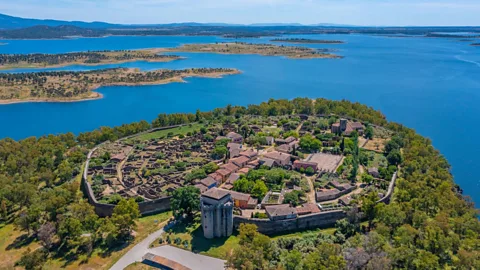A Spanish town abandoned by mistake

In the 1960s, the Spanish government evicted a historical village that was supposed to get flooded by the waters of a new reservoir. Only it never did.
The medieval fortress town of Granadilla is a ghost town. Visitors can peek into empty rooms, wander along its walled-in streets and view the town from atop its castle. But no one lives there. Not since all the residents were kicked out in the 1960s.
Originally founded by Muslims in the 9th Century, Granadilla occupied a strategic spot that allowed its occupants to keep a watchful eye on the Ruta de la Plata, an ancient trade and travel route across the region.
Over the years, rule of the town changed hands, and today it's one of the few Spanish fortress villages where the ancient walls are still intact. But the community that lived here right up until the 1960s is not.
The end began back in the 1950s, during the dictatorship of Francisco Franco, when Spain embarked on massive project of building dams as a way to boost the economy during the period of isolation. The largest of these efforts was the Gabriel y Galán reservoir on the Alagón River, and in 1955, officials decreed that Granadilla was in the floodplain and therefore had to be evacuated.
Over the course of 10 years, from 1959 to 1969, all 1,000 residents were forcibly evicted, many relocated to colonisation settlements near the village. When the water started to rise in 1963, it covered all except one route into the village, turning it into a peninsula. But that's as high as the water got – the town itself never flooded. Nevertheless, the residents were not allowed to return.
The experience was traumatic for locals, many of whom still carry their frustration. "It was a travesty," said Eugenio Jiménez, president of the Association Sons of Granadilla. "They kicked us out, claiming that the dam would flood the town, which was impossible because the town is higher than the dam. But those were times of dictatorship, and we had no rights. But what truly frustrates me is that during democratic times, I've been struggling for the recovery of Granadilla with the former children's association, and no government has listened to us."
Purificación Jiménez, a former resident, also recalled the difficulty of those years. "I remember that every time a family left the village, everyone came out to the entrance of the village to say goodbye and cried," she said.
Even today, villagers have not been allowed to reclaim their homes because the government maintains the flooding decree signed by Franco. However, visitors can and do come for day trips. The town was designated a Historic-Artistic Site in 1980 and is now run as a free, open-air museum (overseen by the Autonomous National Parks Agency). As for the residents, they and their descendants meet up twice a year back in town, on All Saints' Day (1 November) and the Day of the Assumption of Mary (15 August).
This video is part of BBC Reel's Forgotten Places playlist.
---
Join more than three million BBC Travel fans by liking us on Facebook, or follow us on Twitter and Instagram.
If you liked this story, sign up for the weekly bbc.com features newsletter called "The Essential List". A handpicked selection of stories from BBC Future, Culture, Worklife and Travel, delivered to your inbox every Friday.
